The Covid-19 pandemic has posed serious questions to arts and cultural organisations across the country. One of the biggest has been: how do you continue to use the creative arts to empower the most vulnerable in society during lockdown? Nicky Goulder, Founding Chief Executive of Create, tells us how Create Live! enabled them to do this and what they’ve learnt.

On 24 March, all our projects, which rely on face-to-face interactions, ground to a halt.
At Create, we use the creative arts to empower lives and enhance wellbeing. We bring together primary school children in areas of deprivation with disabled adults. We offer young and adult carers vital time away from their responsibilities. We take workshops into prisons and adolescent mental-health units. We work with older people experiencing loneliness. Reducing isolation for these people is central to our mission. But how do you achieve that when everyone has to isolate?
We knew we had to find a way and researched, piloted and launched Create Live!, a new method of digital delivery, in just 14 days. We have now rolled out photography, music, art, drama and dance projects with vulnerable participants across the UK. An emergency response grant from Arts Council England is enabling us to extend this work further.
We had to adapt – fast – to move from in-person to digital workshops. So what have we learnt?
Navigating technology
Getting creative virtually can be a challenge. The key is taking what might seem a limitation and using it to open up new possibilities. We decided to celebrate the home.
Photographer and Create artist Alejandra Carles-Tolra responded by asking young carers to photograph the personal things around them, to look at their homes with new eyes and find inspiration in everyday objects. Exploring their homes and then returning to the screen to collaborate with others provided a creative outlet for self-expression and an opportunity to connect with other young carers.
“Collaboration is always at the centre of my work,” Alejandra says, “and during this period of increased isolation it felt essential that the young carers could collaborate and share their creative work and ideas with each other. It doesn’t matter what tools you have, it’s a way of looking at the world.”
“It doesn’t matter what tools you have, it’s a way of looking at the world.”
Alejandra Carles-Tolra
Safety and comfort
Ensuring participants are safe and comfortable is crucial. We updated our Safeguarding Policy after detailed research; and focus on the smallest details to help them feel calm and relaxed. We ensure, for example that participants names – but only first names – are correctly displayed.
Theatre maker/writer and Create artist James Baldwin explains, “Making a group connection is tricky when you’re disconnected physically, so it’s important to prioritise things that might seem small but make the participants feel comfortable. It’s about being able to embrace the technology to achieve your aim: to have fun and make the participants feel valued.”

Innovating when there’s no IT access
Lack of access to computers or the Internet can pose a real barrier to running our projects. So we adapted Create Live! and ran music workshops with our older participants over the phone.
“[The workshop] made a hell of a difference to me,” said one participant. “I was on the phone for three hours! It has woken me up. I was beginning to get tired with nothing to do, no one to talk to. I really enjoyed it today. I will sleep tonight.”
Feedback across our Create Live! projects from participants, parents, community partners and artists has highlighted how important creativity is for wellbeing in these strange times. We are continuing to adapt and increase the number of workshops being delivered through Create Live! in order to reach as many isolated, vulnerable people as possible during this lockdown period and beyond.
“[The workshop] made a hell of a difference to me…I was beginning to get tired with nothing to do, no one to talk to. I really enjoyed it today.”
Participant
This blog was originally published by Arts Council England on July 10th 2020.

